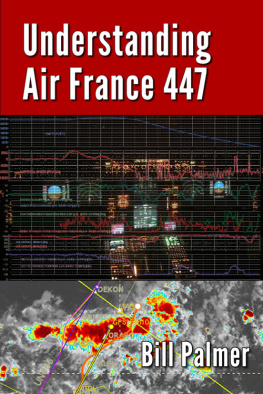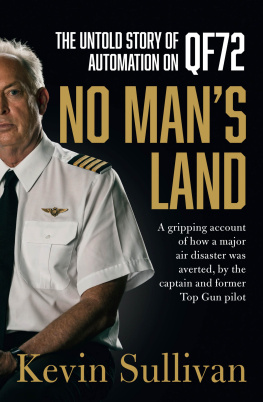Appendix
Recommendations of the Investigation
The BEA released a number of safety recommendations in the various reports on the accident. These cover a range of subjects from airplane an simulator design to search and rescue. In the final report they are grouped primarily by which report the recommendations were issued in. I have arranged them below by subject.
Flight Recorders
Extend as rapidly as possible from 30 to 90 days the regulatory transmission time for Underwater locator Beacons (ULBs) installed on flight recorders on airplanes performing public transport flights over maritime areas; make it mandatory, as rapidly as possible, for airplanes performing public transport flights over maritime areas to be equipped with an additional ULB capable of transmitting on a frequency (for example between 8.5 kHz and 9.5 kHz) and for a duration adapted to the prelocalization of wreckage;
Study the possibility of making it mandatory for airplanes performing public transport flights to regularly transmit basic flight parameters (for example position, altitude, speed, heading).
Ask the FLIRECP (ICAO Flight Recorder Panel) group to establish proposals on the conditions for implementing deployable recorders of the Eurocae ED-112 type for airplanes performing public transport flights.
That ICAO require that aircraft undertaking public transport flights with passengers be equipped with an image recorder that makes it possible to observe the whole of the instrument panel; and that at the same time, ICAO establish very strict rules for the readout of such recordings in order to guarantee the confidentiality of the recordings.
Today, the regulation requires recording of the flight parameters displayed on the left side. Some parameters essential to the analysis of the conduct of the flight are lacking, in particular those displayed to the pilot in the right seat: speed, altitude, attitudes, position of the flight director crossbars, etc. In addition, airplanes are equipped with complex systems whose functional analysis is limited and delayed by the absence of a recording of all of the data sources that they use.
Consequently, the BEA recommends: that EASA and the FAA make mandatory the recording:
- of the position of the flight director crossbars,
- of the parameters relating to the conduct of the flight displayed on the right side, in addition to those displayed on the left side.
And that EASA and the FAA evaluate the relevance of making mandatory the recording of the air data and inertial parameters of all of the sources used by the systems.
That EASA and ICAO make mandatory as quickly as possible, for airplanes making public transport flights with passengers over maritime or remote areas, triggering of data transmission to facilitate localization as soon as an emergency situation is detected on board;
And that EASA and ICAO study the possibility of making mandatory, for airplanes making public transport flights with passengers over maritime or remote areas, the activation of the emergency locator transmitter (ELT), as soon as an emergency situation is detected on board.
Certification
Undertake studies to determine with appropriate precision the composition of cloud masses at high altitude; and in coordination with the other regulatory authorities, based on the results obtained, to modify the certification criteria.
That EASA and the FAA evaluate the relevance of requiring the presence of an angle of attack indicator directly accessible to pilots on board airplanes.
Training for Manual Aircraft Handling
That EASA review the content of check and training programs and make mandatory, in particular, the setting up of specific and regular exercises dedicated to manual aircraft handling of approach to stall and stall recovery, including at high altitude.
That EASA define additional criteria for access to the role of relief captain so as to ensure better task-sharing in case of augmented crews; and that, provisionally, the DGAC define additional criteria for access to the role of relief captain so as to ensure better task-sharing in case of augmented crews.
Search and Rescue
ICAO ensure the implementation of SAR coordination plans or regional protocols covering all of the maritime or remote areas for which international coordination would be required in the application of SAR procedures, including in the South Atlantic area.
The DGAC, in concert with the other services responsible, develop a homogeneous framework for training and for approval of operators responsible for search and rescue activities in France.
ICAO define the framework for the training of SAR operators in its standards and recommended practices.
Within France: the DGAC designate a point of contact at ICAO for the ARCC that has adequate means to accomplish his/her missions.
ICAO ensure each Member State has a national point of contact and makes his/her contact information available.
ICAO amend Annex 12 on search and rescue operations so as to encourage contracting states to equip their search aircraft with buoys to measure drift and to drop them, when these units are involved in the search for persons lost at sea.
Air Traffic Control
The Brazilian and Senegalese authorities make mandatory the utilization, by airplanes so equipped, of ADS-C and CPDLC functions in the zones in question.
ICAO request the involved States to accelerate the operational implementation of air traffic control and communication systems that allow a permanent and reliable link to be made between ground and airplane in all of the areas where HF remains the only means of communication between the ground and airplanes.
Pilot Training
EASA ensure the integration, in type rating and recurrent training programs, of exercises that take into account all of the reconfiguration laws. The objective sought is to make its recognition and understanding easier for crews especially when dealing with the level of protection available and the possible differences in handling characteristics, including at the limits of the flight envelope.
More generally, EASA ensure that type rating and recurrent training programs take into account the specificities of the aircraft for which they are designed.
EASA define recurrent training program requirements to make sure, through practical exercises, that the theoretical knowledge, particularly on flight mechanics, is well understood.
EASA review the requirements for initial, recurrent and type rating training for pilots in order to develop and maintain a capacity to manage crew resources when faced with the surprise generated by unexpected situations.
EASA ensure that operators reinforce CRM training to enable acquisition and maintenance of adequate behavioral automatic responses in unexpected and unusual situations with a highly charged emotional factor.
EASA define criteria for selection and recurrent training among instructors that would allow a high and standardized level of instruction to be reached.
Flight Simulators
EASA modify the basis of the regulations in order to ensure better fidelity for simulators in reproducing realistic scenarios of abnormal situations.
EASA ensure the introduction into the training scenarios of the effects of surprise in order to train pilots to face these phenomena and to work in situations with a highly charged emotional factor.
Ergonomics
EASA require a review of the re-display and reconnection logic of the flight directors after their disappearance, in particular to review the conditions in which an action by the crew would be necessary to re-engage them.
Further, even if it is not sure that the crew followed the orders from the flight director while the stall warning was active, the orders from the crossbars were in contradiction with the inputs to make in this situation and thus may have troubled the crew.











